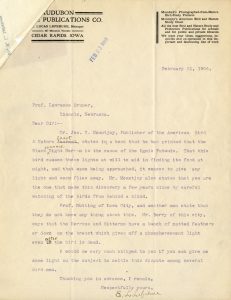Great Nebraska
Naturalists and ScientistsNOU, E.F. Lefebure, Letter, 1906, Feb. 21
 AUDUBON PUBLICATIONS CO. Lucas Lefebure, Manager 227 Masonic Temple Cedar Rapids, Iowa
AUDUBON PUBLICATIONS CO. Lucas Lefebure, Manager 227 Masonic Temple Cedar Rapids, Iowa
Mumford’s Photographed-from-Nature Bird-Study Pictures Mountjoy’s American Bird and Nature Study Chart All the best Bird and Nature Study and Protection Publications for schools and for public and private libraries We want your ideas, suggestions, inquiries and co-operation in this important and fascinating line of work
FEB 23 Ans’d February 21, 1906.
Prof. Lawrence Bruner, Lincoln, Nebraska.
Dear Sir:– Mr. Jno. C. Mountjoy, Publisher of the American Bird & Nature Chart, states in a book that he has printed that the Black crowned Night Heron is the cause of the Ignis Fatuuis. That this bird causes these lights at will to aid in finding its food at night, and that upon being approached it ceases to give any light and soon flies away. Mr. Mountjoy also states that you are the one that made this discovery a few years since by careful watching of the birds from behind a blind. Prof. Nutting of Iowa City, and another man state that they do not know any thing about this. Mr. Berry of this city, says that the Herrons and Bitterns have a bunch of matted feathers or down on the breast which gives off a phosphorescent light even after the bird is dead. I would be very much obliged to you if you can give me some light on the subject to settle this dispute among several bird men. Thanking you in advance, I remain, Respectfully yours, E. L. Lefebure